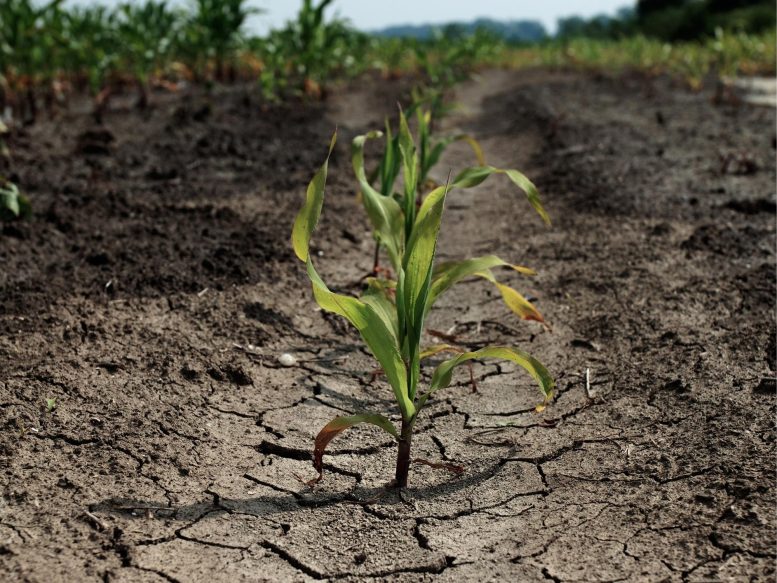
To assess how climate warming will change risks such as crop failures and wildfires, it’s necessary to look at how the risks are likely to interact.
Troubles never come singly, the proverb says. A new NASA research study shows that the old adage will become increasingly true of climate problems as the Earth warms. According to the study, extreme weather events such as floods and heatwaves will increasingly cluster closer in time and location, increasing the risks of crop failures, wildfires, and other hazards to society.
According to the study, which was published in the journal Environmental Research Letters, by the year 2100, increases in heatwaves, drought, and excessive rainfall combined will double the risk of climate-related corn harvest failures in at least three of the world’s six major corn-growing regions in the same year. The Midwest of the United States is most vulnerable to one of these multiple harvest failures.
Many earlier studies have modeled changes in a single climate indicator, such as the number of days in a given location that exceed 100 degrees Fahrenheit (38 degrees Celsius). However, the biggest effects generally occur when extremes occur at the same time or in close succession. Western states, for example, are all too acquainted with the situation in which severe heat and drought feed a wildfire, followed by heavy rainfall that generates a new danger, landslides, in the burned region.

Climate scientists have been working for years to understand and represent these complex chains of interacting events numerically in climate models – a daunting task that pushes the limits of available computing power. “It’s only in the last five or so years that a framework has been developed for applying compound-risk thinking to climate analysis in a way that you can actually compute without getting in hopelessly over your head,” said study lead author Colin Raymond, a scientist at NASA’s Jet Propulsion Laboratory in Southern California.
For their study, the research team used a well-known German climate model called the Max Planck Institute Grand Ensemble to run 100 individual simulations of the years 1991 to 2100. The simulations of the past (1991 to 2020) showed that the model was able to represent extreme-event clusters, such as the alteration of extreme heat with extreme rainfall, consistently with the way they actually occurred during that period. The researchers analyzed simulations of the future through 2100 to examine probable future changes in climate hazards, particularly in hazards that could occur simultaneously or in close succession.
Raymond and his colleagues focused on how the increased clustering of both temperature and precipitation hazards will affect corn. This important food crop is grown worldwide, with six major regions, or breadbaskets, accounting for about two-thirds of all production. The U.S. is the world’s top corn grower, harvesting some 419 million tons (380.3 million metric tonnes) in 2021.
The model simulations showed that by 2100, extreme heatwaves around the world lasting at least three days will occur two to four times as often as they do now. Three-day extremes in rainfall will generally increase 10% to 50% in frequency. The researchers also analyzed how these increased events will cluster in time and in location. They then looked at how all of these changes combined could affect future corn harvests, using the relationship between climate extremes in heat and rainfall and past crop failures as a guide.
By their best estimate, the chance that a cluster of events will cause corn crops to fail in at least three of the world’s breadbaskets in the same year will nearly double, from 29% to 57%, by the year 2100. While small, the chance that harvests will fail in the five largest breadbasket regions in a single year will grow even more significantly – from 0.6% to 5.4%. The U.S. Midwest is the region most likely to be included in years with three breadbasket failures, followed by Central Europe.
The study also examined how risks to wildfires and human health would increase as extremes follow one another more closely. All the results showed, Raymond said, that “things are interconnected in a way that we haven’t quite appreciated up to this point. It’s not just heatwaves. It’s not just heat and drought. It’s all of those interconnections that best explain the severe impacts we care most about when we’re trying to prevent major disasters.”
Reference: “Increasing spatiotemporal proximity of heat and precipitation extremes in a warming world quantified by a large model ensemble” by Colin Raymond, Laura Suarez-Gutierrez, Kai Kornhuber, Madeleine Pascolini-Campbell, Jana Sillmann and Duane E Waliser, 8 March 2022, Environmental Research Letters.
DOI: 10.1088/1748-9326/ac5712
2 Comments
“As climate hazards—such as heat, drought, and precipitation extremes—occur more closely in space and/or time, they increasingly pose far-reaching challenges to societal and ecological resilience.”
Their introduction starts with a conjecture that is stated as though it were fact. They base their conjecture on a climate model of dubious skill, rather than historical data that supports the conjecture.
I have demonstrated that the claim of increasing frequency or severity of heat waves has no support from global empirical data:
https://wattsupwiththat.com/2019/09/06/the-gestalt-of-heat-waves/
I live in an area of Canada where the peak summer to lowest winter temperatures in the past 30 years have gone from 30C. to 90C.!!!! The only food plant that grows reliably here is corn.